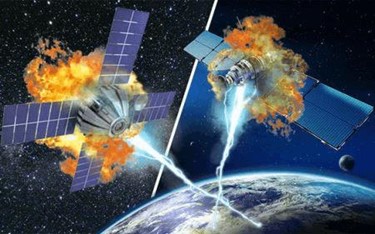Conquering Space By Moving Data Faster

By John Oncea, Editor

Downlinking massive amounts of data from space to Earth is imperative to evolving scientific missions. Now, with NASA’s successful demonstration of laser communications as a practical tool for transferring data from space to ground, moving data has never been speedier.
“Since the late 1990s, laser communication, also known as Free Space Optics (FSO), has been employed as an alternative to traditional communication methods like fiber optics and radio frequencies, offering high bandwidth and enhanced security capabilities,” writes SatMagazine. “While laser communication has been widely used in various terrestrial and satellite applications, its adoption in space-to-ground optical links has been relatively slower.”
In 1995, a major accomplishment was made in the field of laser communications. JAXA's GEO satellite, ETS-VI, effectively transmitted a downlink signal that was received at Japan's National Institute of Information and Communications Technology (NICT) Optical Ground Station in Tokyo. This achievement demonstrated a communication rate of 1 Mbps and represented a significant advancement for laser comms.
Since then, the number of experimentation efforts linking Earth to Low Earth Orbit (LEO) satellites have multiplied:
- In 2020, Sony Computer Science Laboratories (CSL) partnered with JAXA to create a two-way optical communication connection between the Japanese Experiment Module Kibo on the International Space Station and the NICT Optical Ground Station.
- In 2021, CSL collaborated with Kongsberg Satellite Services (KSAT) to showcase an optical downlink transmission from the ISS, which was received at KSAT's commercial optical ground station in Greece.
Now, the TBIRD platform – currently orbiting Earth on NASA's Pathfinder Technology Demonstrator 3 satellite – is shedding light on a possible path toward optical communications with very high data rates, both within and beyond low Earth orbit.
Laser Communication: A Long Time Coming
To paraphrase Buddy the Elf: You did it! Congratulations! Fastest space-to-ground laser communication ever! Great job, everybody!
A team of researchers from NASA, MIT, and other institutions achieved a groundbreaking milestone in space communication technology by establishing a laser-communication link between a satellite in orbit and Earth that achieved an unprecedented data rate of 200 gigabits per second. This achievement is the highest ever recorded in optical communication technology, doubling the record the same team set last year.
“The new communications link was made possible with the TeraByte InfraRed Delivery (TBIRD) system orbiting about 530 kilometers above Earth’s surface,” writes IEEE Spectrum. “Launched into space last May, TBIRD achieved downlink rates of up to 100 Gb/s with a ground-based receiver in California by last June. This was 100 times as fast as the quickest internet speeds in most cities, and more than 1,000 times as fast as radio links traditionally used for communications with satellites.”
The TBIRD payload was built by the MIT Lincoln Laboratory and integrated into NASA’s Pathfinder Technology Demonstrator 3 Satellite (PTD-3), built by Terran Orbital. This is part of NASA’s Space Communications and Navigation (SCaN) program.
“The implications are far-reaching because, put simply, more data means more discoveries,” said Jason Mitchell, an aerospace engineer at NASA’s Space Communications and Navigation program. Beth Keer, mission manager for TBIRD added, “Just imagine the power of space science instruments when they can be designed to fully take advantage of the advancements in detector speeds and sensitivities, furthering what artificial intelligence can do with huge amounts of data. Laser communications are the missing link that will enable future scientific discoveries.”
NASA currently relies on radio technology for space communications, which uses similar methods to send data as radio broadcasts or cell phones communicating with cell towers. However, with plans for a long-term presence on the Moon and future missions to Mars, more efficient communication methods are needed for successful operations and scientific research.
Laser communications, also known as optical communications, offer ultra-high-speed capabilities that enable more data to be transmitted from space. CubeSats, such as PTD-3, provide a cost-effective and small-sized option for testing communication technologies. PTD-3, which is only about the size of two stacked cereal boxes, was launched into orbit on SpaceX's Transporter-5 rideshare mission from NASA's Kennedy Space Center in Florida. It also was synchronized with Earth's orbit around the Sun, allowing it to maintain a fixed position relative to the Sun, and pass over Earth’s ground station twice daily for TBIRD to test the space-to-ground communications link.
What’s Next?
The research team’s next step is to explore where to apply this technology in upcoming missions, writes IEEE Spectrum. “This technology is particularly useful for science missions where collecting a lot of data can provide significant benefits,” Kat Riesing, aerospace engineer, MIT Lincoln Laboratory says. “One mission concept that is enabled by this is the Event Horizon Explorer mission, which will extend the exciting work of the Event Horizon Telescope in imaging black holes with even higher resolution.”
Scientists are interested in expanding the usage of this technology in various situations, including geostationary ones. They are also exploring ways to enhance TBIRD's capabilities to support future missions on the moon, which is a considerable distance away from Earth. Although the rates being considered only range from 1 to 5 Gb/s, it is important to note that the moon is approximately 400,000 km away from Earth, which is quite a significant distance to cover.
The new technology may also find use in high-speed atmospheric data links on the ground. “For example, from building to building, or across inhospitable terrains, such as from mountaintop to mountaintop, where the cost of laying fiber systems could be exorbitant,” Riesing says.
